Source Analysis Based on the Positive Matrix Factorization Models and Risk Assessment of Heavy Metals in Agricultural Soil
Abstract
1. Introduction
2. Materials and Methods
2.1. Description of the Study Area
2.2. Sample Collection and Analysis
2.3. PMF Model
2.4. Risk Assessment of Heavy Metals in Soil
2.5. Coefficient of Variation
3. Results
3.1. Characteristics of Soil Heavy Metal Content in the Study Area
3.2. The Factor Contribution Rate Based on PMF
3.3. Soil Heavy Metal Risk Assessment
4. Discussion
4.1. Analysis of Soil Heavy Metal Content and Differences in the Study Area
4.2. Research on Pollution Source Analysis and Risk Assessment based on PMF Method
4.3. Analysis of the Difference between Carcinogenic Risk and Non-Carcinogenic Risk
5. Conclusions
- The heavy metal content in soil did not show regularity as a whole, and the distribution of heavy metal content was affected by the environment. Cd in the four areas had a pollution risk.
- Based on the PMF model, this study showed that area 1, area 2, and area 3 had three pollution source factors, and area 4 had two pollution source factors. The sources of pollution were soil parent material, traffic factors, agricultural chemical use, industrial factors, etc.
- The non-carcinogenic risk of heavy metals in children at all points in the study area was greater than that in adults. The risk of heavy metal Cr to children and adults was higher than that of other heavy metals. For the probability of carcinogenic risk, the risk pathway in adults was greater than that in children. And the most serious carcinogenic risk in the study area was the harm caused by oral ingestion of heavy metal Cr into the adults’ body.
- The results of human health risk evaluation showed that Cr and Cd were more harmful than Ni, Cu, and Pb, and should be prevented.
Author Contributions
Funding
Informed Consent Statement
Data Availability Statement
Acknowledgments
Conflicts of Interest
References
- Chen, H.; Wang, Y.; Wang, S. Analysis and pollution assessment of heavy metals in farmland around Tongshan mining area. Environ. Sci. 2022, 43, 2719–2731. (In Chinese) [Google Scholar]
- National Soil Pollution Survey Bulletin. National Soil Pollution Survey Bulletin (April 17, 2014). volume 1. Environ. Educ. 2014, 8–10. Available online: https://www.gov.cn/foot/2014-04/17/content_2661768.htm (accessed on 18 July 2023). (In Chinese)
- Chapman, P.M.; Wang, F.; Adams, W.J.; Green, A. Appropriate applications of sediment quality values for metals and metalloids. Environ. Sci. Technol. 1999, 33, 3937–3941. [Google Scholar] [CrossRef]
- Zhang, Z.; Yu, N.; Liu, D.; Zhang, Y. Assessment and source analysis of heavy metal contamination in water and surface sediment in Dongping Lake, China. Chemosphere 2022, 307, 136016. [Google Scholar] [CrossRef] [PubMed]
- Adgate, J.L.; Willis, R.D.; Buckley, T.J.; Chow, J.C.; Watson, J.G.; Rhoads, G.G.; Lioy, P.J. Chemical mass balance source apportionment of lead in house dust. Environ. Sci. Technol. 1998, 32, 108–114. [Google Scholar] [CrossRef]
- Kou, J.; Gan, Y.; Lei, S.; Meng, W.; Feng, C.; Xiao, H. Soil health and ecological risk assessment in the typical coal mines on the Mongolian Plateau. Ecol. Indic. 2022, 142, 109189. [Google Scholar] [CrossRef]
- Chen, W.; Yang, Y.; Xie, T.; Wang, M.; Peng, C.; Wang, L. Challenges and countermeasures of heavy metal pollution prevention and control in farmland soil in China. Acta Pearthen Sin. 2018, 55, 261–272. (In Chinese) [Google Scholar]
- Muthu, S.S. Assessment of Carbon Footprint in Different Industrial Sectors; Springer Science & Business: Berlin/Heidelberg, Germany, 2014; Volume 1. [Google Scholar]
- Zeng, W.; Wan, X.; Wang, L. Apportionment and location of heavy metal (loid) s pollution sources for soil and dust using the combination of principal component analysis, Geodetector, and multiple linear regression of distance. J. Hazard. Mater. 2022, 438, 129468. [Google Scholar] [CrossRef]
- Liao, S.; Jin, G.; Khan, M.A. The quantitative source apportionment of heavy metals in peri-urban agricultural soils with UNMIX and input fluxe analysis. Environ. Technol. Innov. 2021, 21, 101232. [Google Scholar] [CrossRef]
- Wang, Y.; Guo, G.; Zhang, D.; Lei, M. An integrated method for source apportionment of heavy metal (loid) s in agricultural soils and model uncertainty analysis. Environ. Pollut. 2021, 276, 116666. [Google Scholar] [CrossRef]
- Ai, J.-C.; Wang, N.; Yang, J. Source apportionment of soil heavy metals in Jiapigou goldmine based on the UNMIX model. Environ. Sci. 2014, 35, 3530–3536. [Google Scholar]
- Zhu, G.; Guo, Q.; Xiao, H.; Chen, T.; Yang, J. Multivariate statistical and lead isotopic analyses approach to identify heavy metal sources in topsoil from the industrial zone of Beijing Capital Iron and Steel Factory. Environ. Sci. Pollut. Res. 2017, 24, 14877–14888. [Google Scholar] [CrossRef] [PubMed]
- Xu, Z.-J.; Zhu, H.-B.; Shu, L.-Y. Estimation of the fraction of soil-borne particulates in indoor air by PMF and its impact on health risk assessment of soil contamination in Guangzhou, China. Environ. Pollut. 2022, 308, 119623. [Google Scholar] [CrossRef] [PubMed]
- Shi, X.-M.; Liu, S. Contamination and source-specific risk analysis of soil heavy metals in a typical coal industrial city, central China. Sci. Total Environ. 2022, 836, 155694. [Google Scholar] [CrossRef]
- Chen, T.; Chang, Q.; Liu, J.; Clevers, J.G.P.W.; Kooistra, L. Identification of soil heavy metal sources and improvement in spatial mapping based on soil spectral information: A case study in northwest China. Sci. Total Environ. 2016, 565, 155–164. [Google Scholar] [CrossRef] [PubMed]
- Dai, Q.; Ding, J.; Song, C. Changes in source contributions to particle number concentrations after the COVID-19 outbreak: Insights from a dispersion normalized PMF. Sci. Total Environ. 2021, 759, 143548. [Google Scholar] [CrossRef]
- Li, Y.; Liu, B.; Xue, Z. Chemical characteristics and source apportionment of PM2. 5 using PMF modelling coupled with 1-hr resolution online air pollutant dataset for Linfen, China. Environ. Pollut. 2020, 263, 114532. [Google Scholar] [CrossRef]
- Su, Y.-C.; Chen, W.-H.; Fan, C.-L. Source apportionment of volatile organic compounds (VOCs) by positive matrix factorization (PMF) supported by model simulation and source markers-using petrochemical emissions as a showcase. Environ. Pollut. 2019, 254, 112848. [Google Scholar] [CrossRef]
- Chen, Z.; Shi, Z.; Ni, S.; Cheng, L. Characteristics of soil pollution and element migration associated with the use of coal in Hutou Village, Yunnan Province, China. Ecol. Indic. 2022, 139, 108976. [Google Scholar] [CrossRef]
- Zhou, L.; Zhao, X.; Meng, Y.; Fei, Y.; Teng, M.; Song, F.; Wu, F. Identification priority source of soil heavy metals pollution based on source-specific ecological and human health risk analysis in a typical smelting and mining region of South China. Ecotoxicol. Environ. Saf. 2022, 242, 113864. [Google Scholar] [CrossRef]
- Wang, J.; Yu, D.; Wang, Y.; Du, X.; Li, G.; Li, B.; Zhao, Y.; Wei, Y.; Xu, S. Source analysis of heavy metal pollution in agricultural soil irrigated with sewage in Wuqing, Tianjin. Sci. Rep. 2021, 11, 17816. [Google Scholar] [CrossRef]
- Qiao, P. Quantitative analysis of the main sources of pollutants in the soils around key areas based on the positive matrix factorization method. Environ. Pollut. 2021, 273, 116518. [Google Scholar] [CrossRef]
- Yin, X.; Xie, Z.; Wang, W.; Luo, X.; Shen, L.; Liu, B.; Shao, L. Analysis of soil heavy metal sources in Guangzhou: Comparison of three receptor models. J. Univ. Sci. Technol. China 2021, 51, 813–821. [Google Scholar]
- Jia, X.; Fu, T.; Hu, B.; Shi, Z.; Zhou, L.; Zhu, Y. Identification of the potential risk areas for soil heavy metal pollution based on the source-sink theory. J. Hazard. Mater. 2020, 393, 122424. [Google Scholar] [CrossRef]
- Liu, L.; Xu, X.; Han, J.; Zhu, J.-M. Heavy metal (loid) s in agricultural soils in the world’s largest barium-mining area: Pollution characteristics, source apportionment, and health risks using PMF model and Cd isotopes. Process Saf. Environ. Prot. 2022, 166, 669–681. [Google Scholar] [CrossRef]
- Bhuiyan MA, H.; Karmaker, S.C.; Bodrud-Doza, M.; Rakib, M.A.; Saha, B.B. Enrichment, sources and ecological risk mapping of heavy metals in agricultural soils of dhaka district employing SOM, PMF and GIS methods. Chemosphere 2021, 263, 128339. [Google Scholar] [CrossRef]
- Yadav, P.; Singh, R.; Gupta, N.; Kumar, S.; Thakur, R.S.; Khan, A.; Ansari, N.G.; Patel, D.K. Modified DLLME-SFO approach for evaluation of multiclass agrochemicals and its associated risk assessment: Soil, Saccharum officinarum and Jaggery. Food Chem. Adv. 2022, 1, 100032. [Google Scholar] [CrossRef]
- Albert, R.E. Issues in biochemical applications to risk assessment: How do we predict toxicity of complex mixtures? Environ. Health Perspect. 1987, 76, 185–186. [Google Scholar] [CrossRef][Green Version]
- Chen, C.; Wang, Y.; Qian, Y.; Zhao, X.; Wang, Q. The synergistic toxicity of the multiple chemical mixtures: Implications for risk assessment in the terrestrial environment. Environ. Int. 2015, 77, 95–105. [Google Scholar] [CrossRef]
- Wierzbicka, M. Multidimensional evaluation of soil pollution from railway tracks. Ecotoxicology 2015, 24, 805–822. [Google Scholar] [CrossRef] [PubMed]
- Sarigiannis, D.A.; Hansen, U. Considering the cumulative risk of mixtures of chemicals—A challenge for policy makers. Environ. Health 2012, 11, S18. [Google Scholar] [CrossRef]
- Ho, S.; Cheng, Y.; Bai, Y. Risk Assessment of Indoor Formaldehyde and Other Carbonyls in Campus Environments in Northwestern China. Aerosol Air Qual. Res. 2016, 16, 1967–1980. [Google Scholar] [CrossRef]
- Chen, Z.; Hua, Y.; Xu, W.; Pei, J. Analysis of heavy metal pollution sources in suburban farmland based on positive-definite matrix factor analysis model. J. Environ. Sci. 2020, 40, 276–283. [Google Scholar]
- Liu, G.; Hu, L.; He, Z. Analysis of heavy metal pollution sources in soil. J. Chengdu Univ. Nat. Sci. Ed. 2015, 34, 200–203. [Google Scholar]
- Li, J. Evaluation of Heavy Metal Pollution and Health Risk Assessment of Cultivated Land Based on Soil-Crop-Human System. Master’s Thesis, Zhejiang University, Hangzhou, China, 2019. (In Chinese). [Google Scholar]
- Cai, N. Classification of Soil Heavy Metal Cd Pollution Degree Based on Potato Quality and Safety. Master’s Thesis, Guizhou University, Guiyang, China, 2019. (In Chinese). [Google Scholar]
- Azhar, U.; Ahmad, H.; Shafqat, H.; Babar, M.; Munir, H.M.S.; Sagir, M.; Arif, M.; Hassan, A.; Rachmadona, N.; Rajendran, S.; et al. Remediation techniques for elimination of heavy metal pollutants from soil: A review. Environ. Res. 2022, 214, 113918. [Google Scholar] [CrossRef]
- Yang, Q. A review of soil heavy metal pollution from industrial and agricultural regions in China: Pollution and risk assessment. Sci. Total Environ. 2018, 642, 690–700. [Google Scholar] [CrossRef]
- Wei, Y.; Li, G.; Wang, Y.; Zhang, Q. Influencing Factors of PMF Model: A Case Study of Soil Heavy Metal Source Analysis in Farmland Surrounding a Lead and Zinc Mine. J. Agro-Environ. Sci. 2018, 37, 198–208. [Google Scholar]
- Chai, L.; Wang, X.; Ma, L.; Cheng, Z.; Su, L.; Wang, Y. Analysis of soil heavy metal sources in cultivated land in Lanzhou based on PMF model. China Environ. Sci. 2020, 40, 3919–3929. (In Chinese) [Google Scholar]
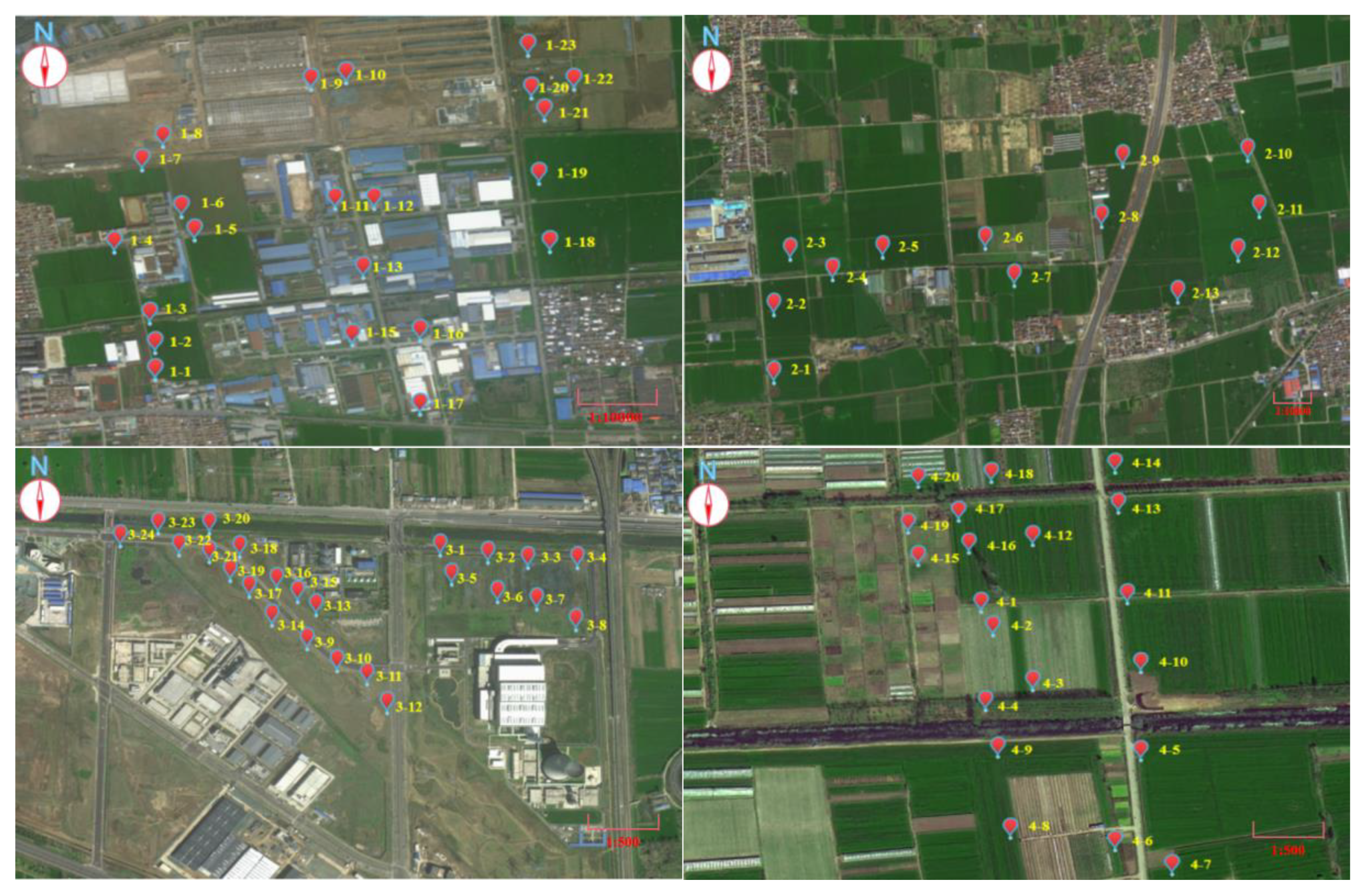
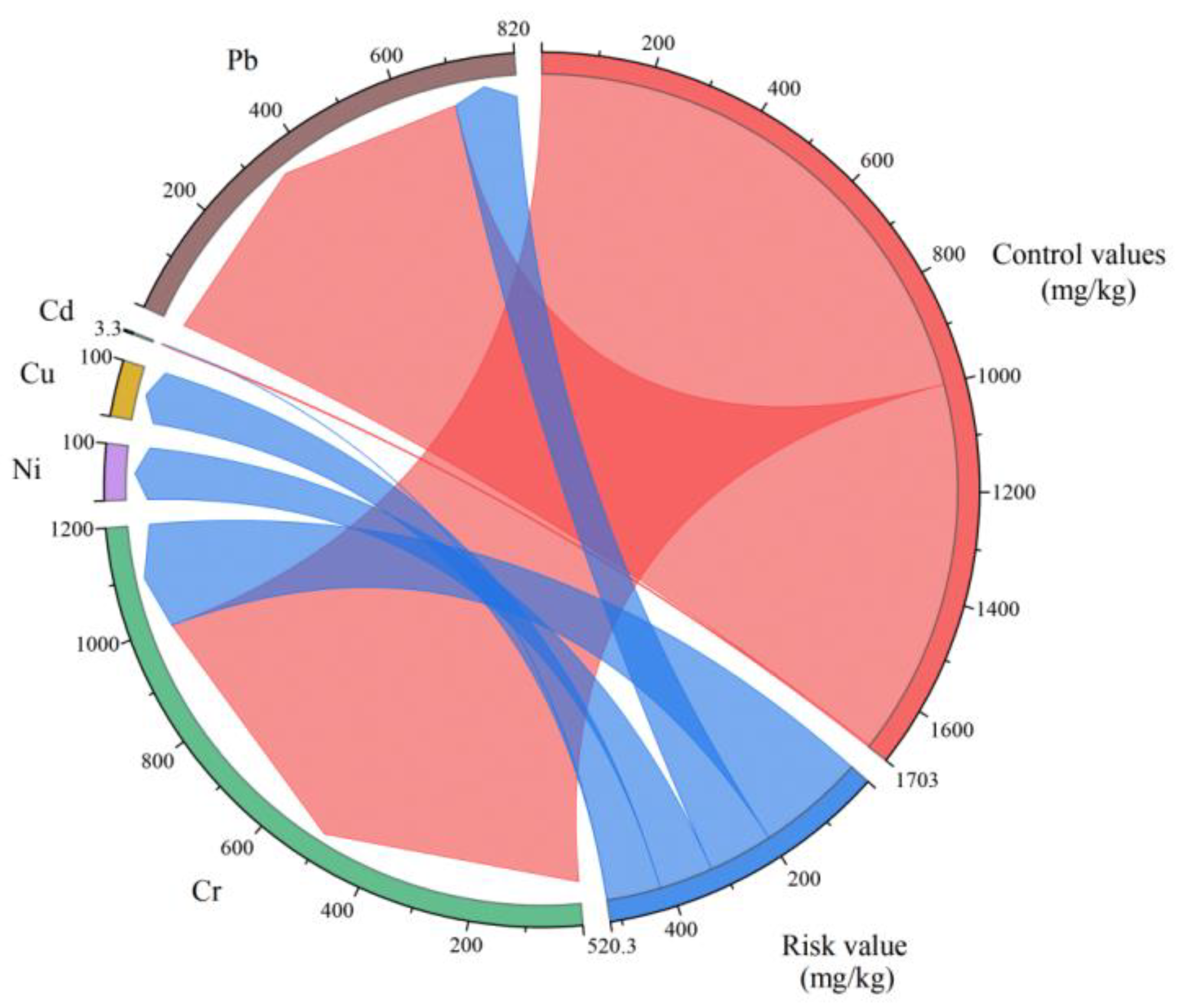
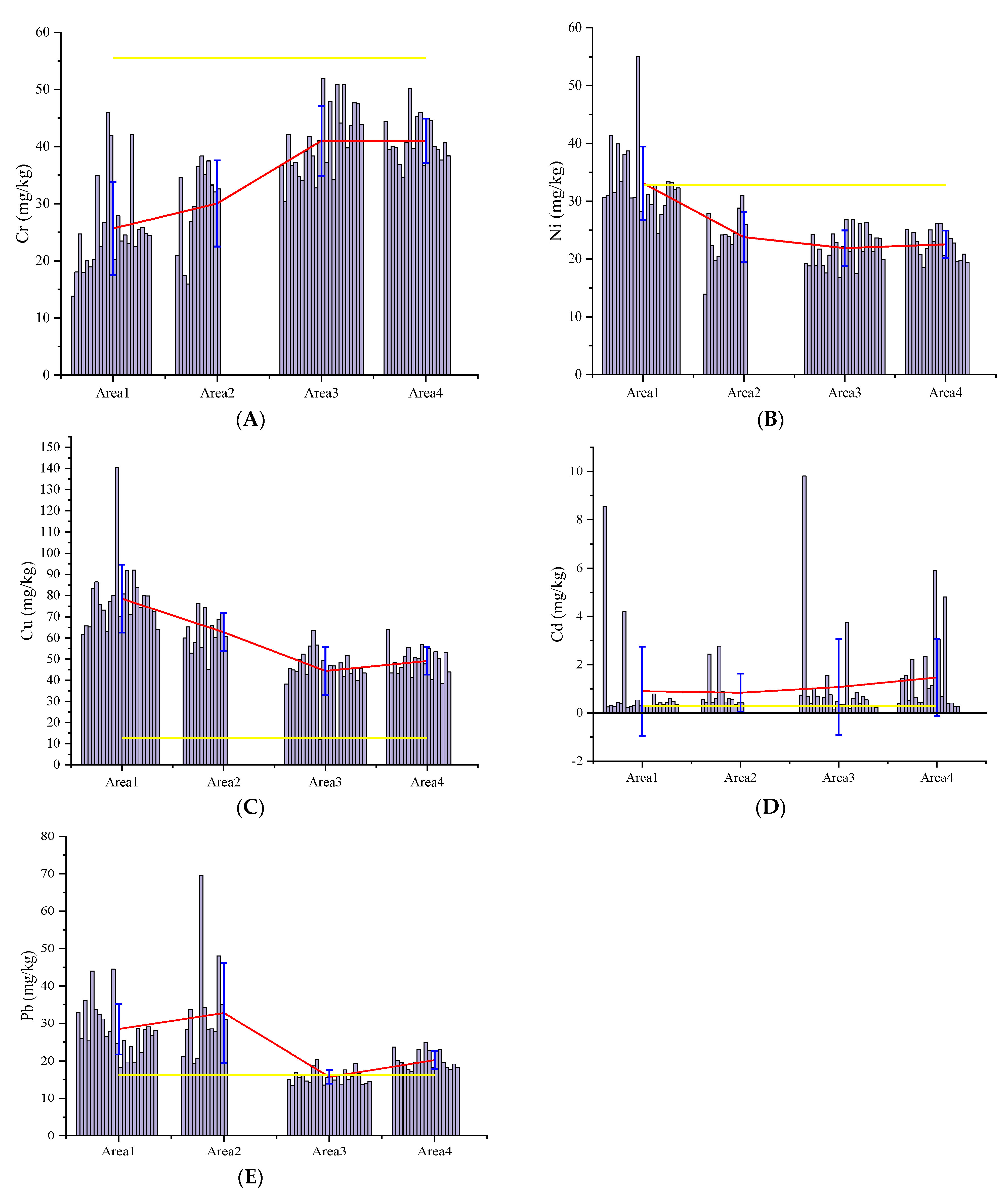
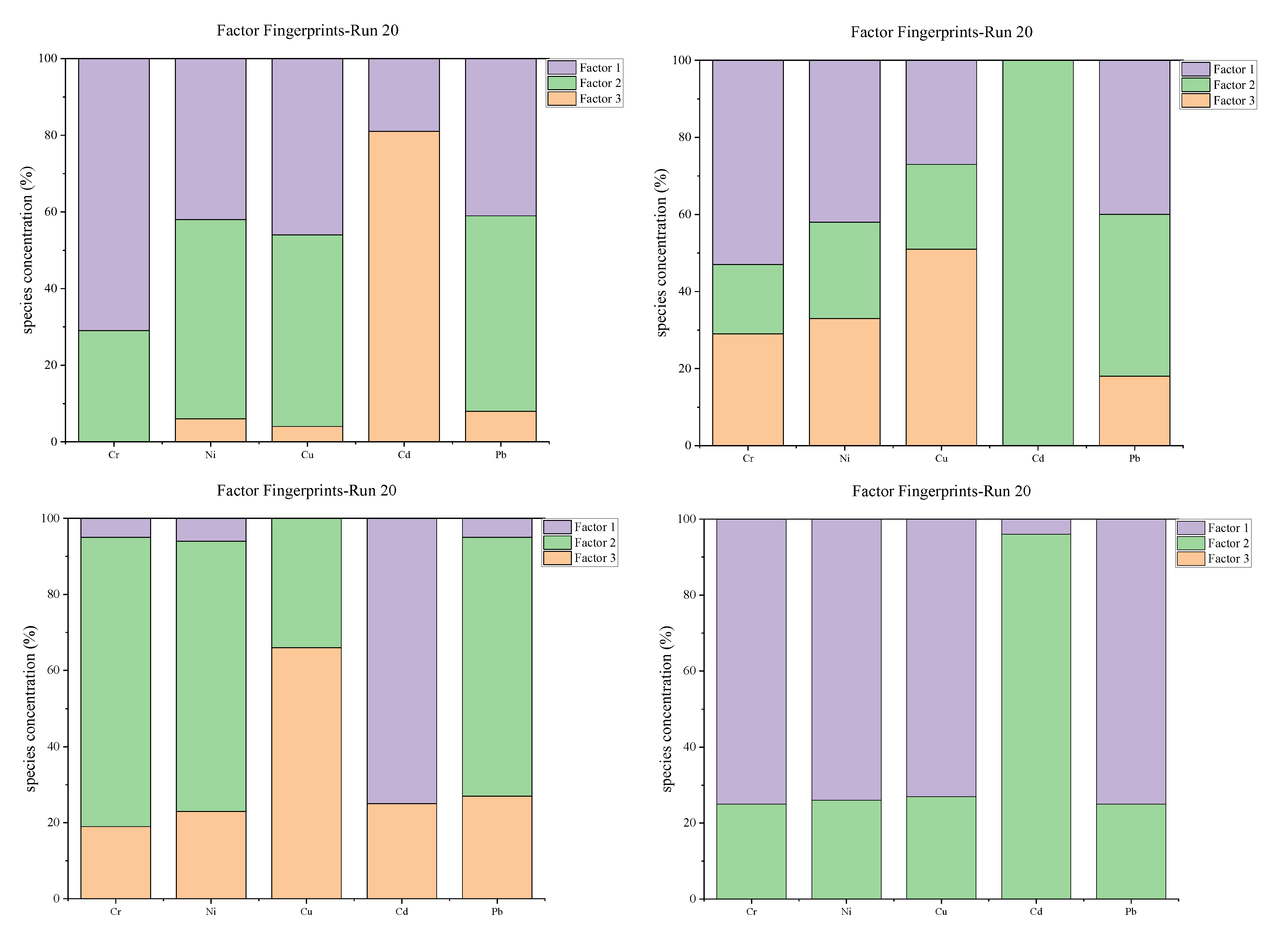
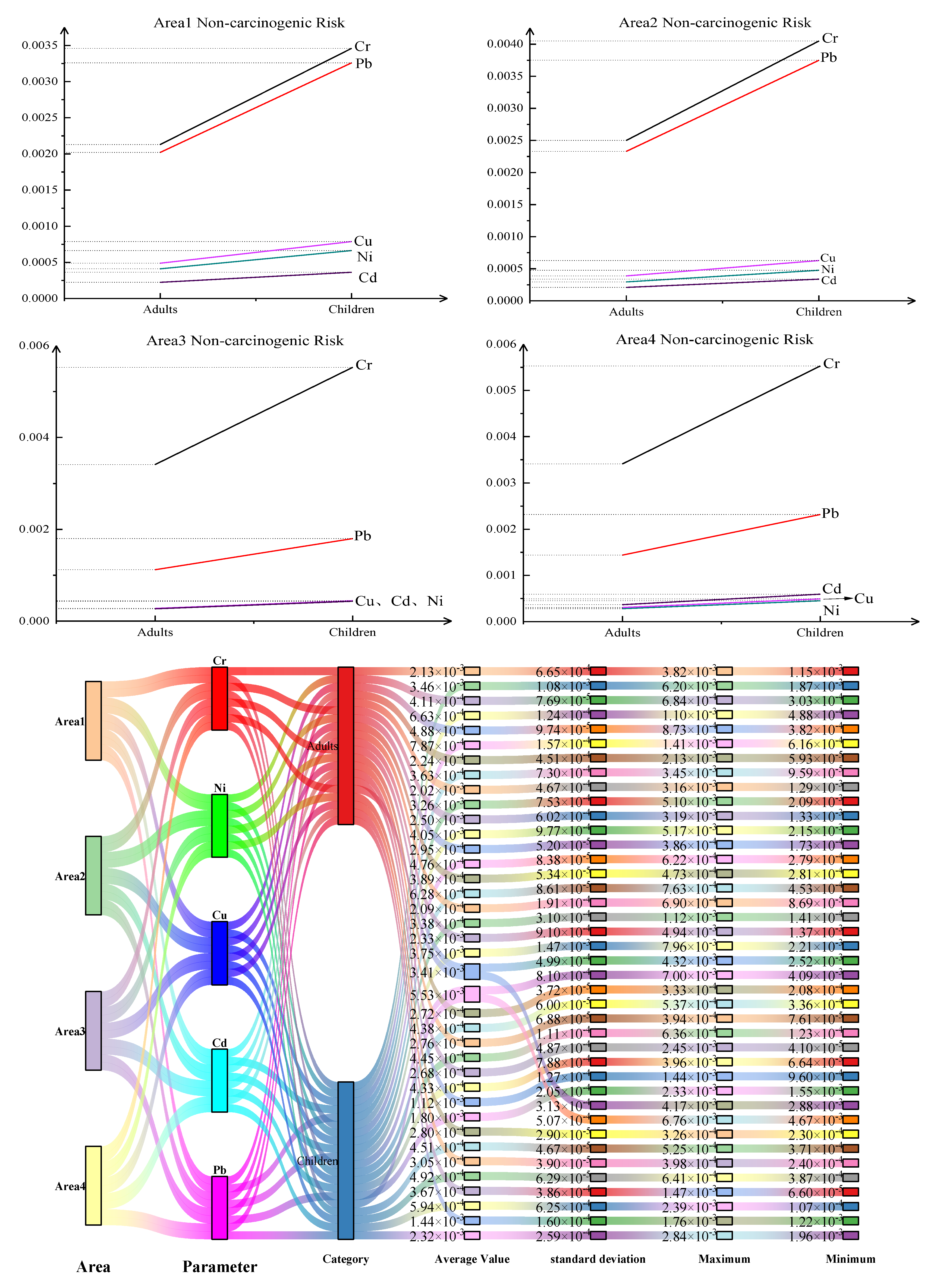
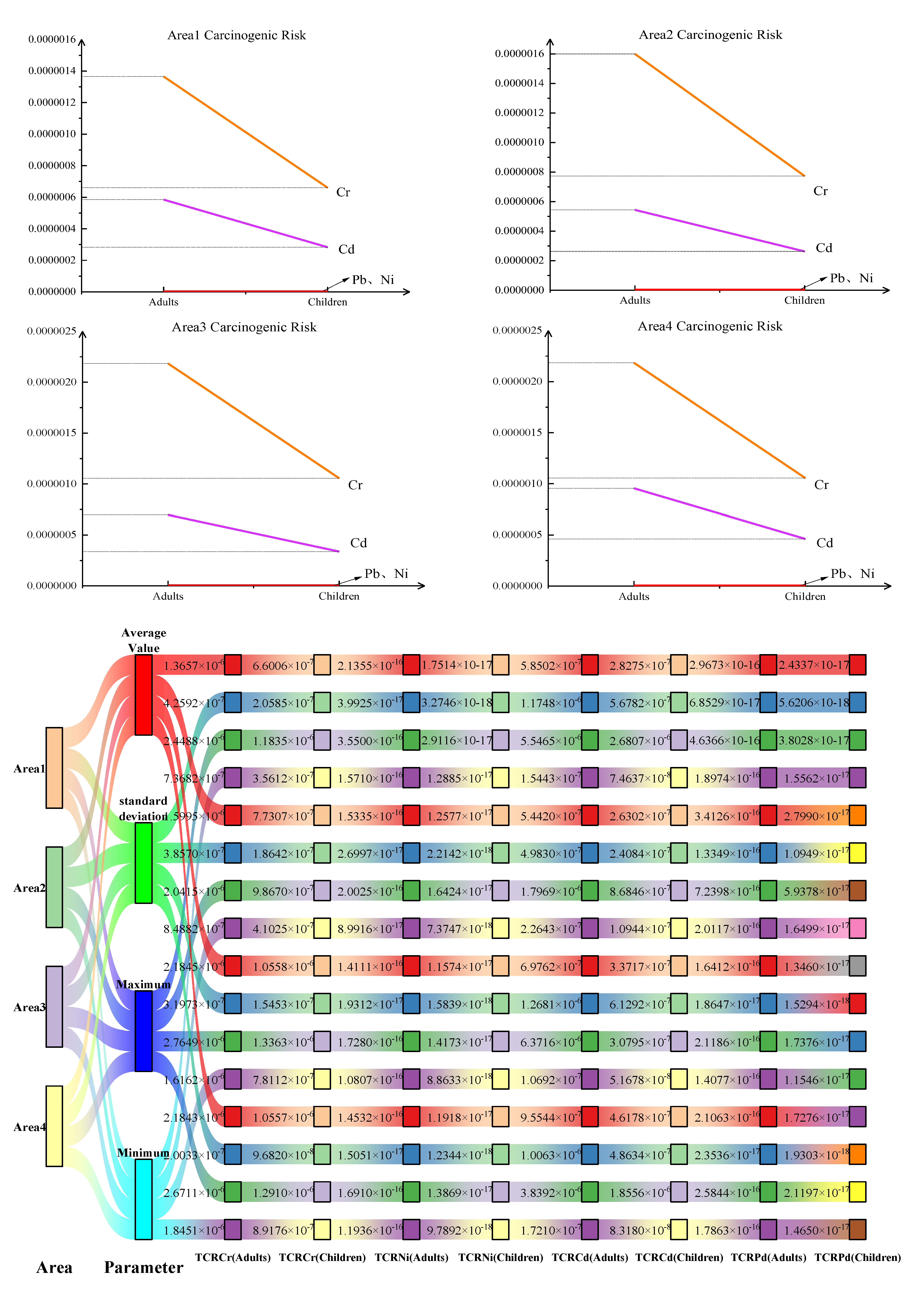
| Reference Dose | Ingestion Mode | Cr | Ni | Cu | Cd | Pb |
|---|---|---|---|---|---|---|
| RfD | Ingested by breath | 0.0000286 | 0.00009 | 0.04 | 0.00001 | 0.00352 |
| Ingested through the skin | 0.00006 | 0.0054 | 0.012 | 0.000025 | 0.000525 | |
| Ingested by mouth | 0.003 | 0.02 | 0.04 | 0.001 | 0.0035 | |
| CSF | Ingested by breath | 84 | 0.26 | 1.8 | 0.042 | |
| Ingested through the skin | 0.001 | 0.38 | ||||
| Ingested by mouth | 0.5 | 6.1 |
| Area | Parameter (mg/kg) | Cr | Ni | Cu | Cd | Pb |
|---|---|---|---|---|---|---|
| Area 1 | average value | 25.65 | 33.12 | 78.57 | 0.9 | 28.49 |
| standard deviation | 8.001 | 6.192 | 15.684 | 1.809 | 6.579 | |
| coefficient of variation | 0.312 | 0.187 | 0.2 | 2.008 | 0.231 | |
| Area 2 | average value | 31.07 | 24.21 | 64.26 | 1.18 | 32.5 |
| standard deviation | 7.902 | 4.323 | 10.031 | 1.444 | 12.386 | |
| coefficient of variation | 0.254 | 0.179 | 0.156 | 1.222 | 0.381 | |
| Area 3 | average value | 41.04 | 21.88 | 44.42 | 1.07 | 15.76 |
| standard deviation | 6.006 | 2.995 | 11.076 | 1.953 | 1.79 | |
| coefficient of variation | 0.146 | 0.137 | 0.249 | 1.818 | 0.114 | |
| Area 4 | average value | 40.66 | 22.37 | 48.59 | 1.42 | 20.04 |
| standard deviation | 4.015 | 2.386 | 6.533 | 1.527 | 2.345 | |
| coefficient of variation | 0.099 | 0.107 | 0.134 | 1.076 | 0.117 |
| Area | Heavy Metal | Cr | Ni | Cu | Cd | Pb |
|---|---|---|---|---|---|---|
| Area1 | Factor1 | 71.1% | 41.5% | 45.8% | 20.6% | 40.9% |
| Factor2 | 28.9% | 52.5 | 49.8 | 0% | 51.2% | |
| Factor3 | 0% | 6.0% | 4.4% | 79.4% | 7.9% | |
| Area2 | Factor1 | 52.6% | 41.9% | 26.7% | 0% | 40.1% |
| Factor2 | 18.6% | 23.9% | 21.2% | 100% | 41.8% | |
| Factor3 | 28.8% | 34.2% | 52.1% | 0% | 18.1% | |
| Area3 | Factor1 | 5.0% | 5.5% | 0% | 75.0% | 4.7% |
| Factor2 | 76.3% | 71.7% | 35.2% | 0% | 68.8% | |
| Factor3 | 18.7% | 22.8% | 64.8% | 25.0% | 26.4% | |
| Area4 | Factor1 | 75.4% | 74.1% | 72.5% | 4.2% | 75.1% |
| Factor2 | 24.6% | 25.9% | 27.5% | 95.8% | 24.9% |
| Area | Heavy Metal | Crowd Category | Average Value | Standard Deviation | Maximum | Minimum |
|---|---|---|---|---|---|---|
| 1 | Cr | Adults | 2.13 × 10−3 | 6.65 × 10−4 | 3.82 × 10−3 | 1.15 × 10−3 |
| Children | 3.46 × 10−3 | 1.08 × 10−3 | 6.20 × 10−3 | 1.87 × 10−3 | ||
| Ni | Adults | 4.11 × 10−4 | 7.69 × 10−5 | 6.84 × 10−4 | 3.03 × 10−4 | |
| Children | 6.63 × 10−4 | 1.24 × 10−4 | 1.10 × 10−3 | 4.88 × 10−4 | ||
| Cu | Adults | 4.88 × 10−4 | 9.74 × 10−5 | 8.73 × 10−4 | 3.82 × 10−4 | |
| Children | 7.87 × 10−4 | 1.57 × 10−4 | 1.41 × 10−3 | 6.16 × 10−4 | ||
| Cd | Adults | 2.24 × 10−4 | 4.51 × 10−4 | 2.13 × 10−3 | 5.93 × 10−5 | |
| Children | 3.63 × 10−4 | 7.30 × 10−4 | 3.45 × 10−3 | 9.59 × 10−5 | ||
| Pb | Adults | 2.02 × 10−3 | 4.67 × 10−4 | 3.16 × 10−3 | 1.29 × 10−3 | |
| Children | 3.26 × 10−3 | 7.53 × 10−4 | 5.10 × 10−3 | 2.09 × 10−3 | ||
| 2 | Cr | Adults | 2.50 × 10−3 | 6.02 × 10−4 | 3.19 × 10−3 | 1.33 × 10−3 |
| Children | 4.05 × 10−3 | 9.77 × 10−4 | 5.17 × 10−3 | 2.15 × 10−3 | ||
| Ni | Adults | 2.95 × 10−4 | 5.20 × 10−5 | 3.86 × 10−4 | 1.73 × 10−4 | |
| Children | 4.76 × 10−4 | 8.38 × 10−5 | 6.22 × 10−4 | 2.79 × 10−4 | ||
| Cu | Adults | 3.89 × 10−4 | 5.34 × 10−5 | 4.73 × 10−4 | 2.81 × 10−4 | |
| Children | 6.28 × 10−4 | 8.61 × 10−5 | 7.63 × 10−4 | 4.53 × 10−4 | ||
| Cd | Adults | 2.09 × 10−4 | 1.91 × 10−4 | 6.90 × 10−4 | 8.69 × 10−5 | |
| Children | 3.38 × 10−4 | 3.10 × 10−4 | 1.12 × 10−3 | 1.41 × 10−4 | ||
| Pb | Adults | 2.33 × 10−3 | 9.10 × 10−4 | 4.94 × 10−3 | 1.37 × 10−3 | |
| Children | 3.75 × 10−3 | 1.47 × 10−3 | 7.96 × 10−3 | 2.21 × 10−3 | ||
| 3 | Cr | Adults | 3.41 × 10−3 | 4.99 × 10−4 | 4.32 × 10−3 | 2.52 × 10−3 |
| Children | 5.53 × 10−3 | 8.10 × 10−4 | 7.00 × 10−3 | 4.09 × 10−3 | ||
| Ni | Adults | 2.72 × 10−4 | 3.72 × 10−5 | 3.33 × 10−4 | 2.08 × 10−4 | |
| Children | 4.38 × 10−4 | 6.00 × 10−5 | 5.37 × 10−4 | 3.36 × 10−4 | ||
| Cu | Adults | 2.76 × 10−4 | 6.88 × 10−5 | 3.94 × 10−4 | 7.61 × 10−5 | |
| Children | 4.45 × 10−4 | 1.11 × 10−4 | 6.36 × 10−4 | 1.23 × 10−4 | ||
| Cd | Adults | 2.68 × 10−4 | 4.87 × 10−4 | 2.45 × 10−3 | 4.10 × 10−5 | |
| Children | 4.33 × 10−4 | 7.88 × 10−4 | 3.96 × 10−3 | 6.64 × 10−5 | ||
| Pb | Adults | 1.12 × 10−3 | 1.27 × 10−4 | 1.44 × 10−3 | 9.60 × 10−4 | |
| Children | 1.80 × 10−3 | 2.05 × 10−4 | 2.33 × 10−3 | 1.55 × 10−3 | ||
| 4 | Cr | Adults | 3.41 × 10−3 | 3.13 × 10−4 | 4.17 × 10−3 | 2.88 × 10−3 |
| Children | 5.53 × 10−3 | 5.07 × 10−4 | 6.76 × 10−3 | 4.67 × 10−3 | ||
| Ni | Adults | 2.80 × 10−4 | 2.90 × 10−5 | 3.26 × 10−4 | 2.30 × 10−4 | |
| Children | 4.51 × 10−4 | 4.67 × 10−5 | 5.25 × 10−4 | 3.71 × 10−4 | ||
| Cu | Adults | 3.05 × 10−4 | 3.90 × 10−5 | 3.98 × 10−4 | 2.40 × 10−4 | |
| Children | 4.92 × 10−4 | 6.29 × 10−5 | 6.41 × 10−4 | 3.87 × 10−4 | ||
| Cd | Adults | 3.67 × 10−4 | 3.86 × 10−4 | 1.47 × 10−3 | 6.60 × 10−5 | |
| Children | 5.94 × 10−4 | 6.25 × 10−4 | 2.39 × 10−3 | 1.07 × 10−4 | ||
| Pb | Adults | 1.44 × 10−3 | 1.60 × 10−4 | 1.76 × 10−3 | 1.22 × 10−3 | |
| Children | 2.32 × 10−3 | 2.59 × 10−4 | 2.84 × 10−3 | 1.96 × 10−3 |
Disclaimer/Publisher’s Note: The statements, opinions and data contained in all publications are solely those of the individual author(s) and contributor(s) and not of MDPI and/or the editor(s). MDPI and/or the editor(s) disclaim responsibility for any injury to people or property resulting from any ideas, methods, instructions or products referred to in the content. |
© 2023 by the authors. Licensee MDPI, Basel, Switzerland. This article is an open access article distributed under the terms and conditions of the Creative Commons Attribution (CC BY) license (https://creativecommons.org/licenses/by/4.0/).
Share and Cite
Yang, D.; Yang, Y.; Hua, Y. Source Analysis Based on the Positive Matrix Factorization Models and Risk Assessment of Heavy Metals in Agricultural Soil. Sustainability 2023, 15, 13225. https://doi.org/10.3390/su151713225
Yang D, Yang Y, Hua Y. Source Analysis Based on the Positive Matrix Factorization Models and Risk Assessment of Heavy Metals in Agricultural Soil. Sustainability. 2023; 15(17):13225. https://doi.org/10.3390/su151713225
Chicago/Turabian StyleYang, Dejun, Yong Yang, and Yipei Hua. 2023. "Source Analysis Based on the Positive Matrix Factorization Models and Risk Assessment of Heavy Metals in Agricultural Soil" Sustainability 15, no. 17: 13225. https://doi.org/10.3390/su151713225
APA StyleYang, D., Yang, Y., & Hua, Y. (2023). Source Analysis Based on the Positive Matrix Factorization Models and Risk Assessment of Heavy Metals in Agricultural Soil. Sustainability, 15(17), 13225. https://doi.org/10.3390/su151713225





